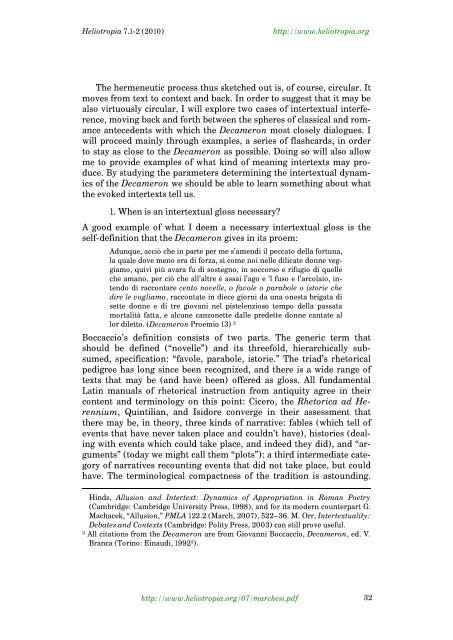Boccaccio's Vernacular Classicism: Intertextuality ... - Brown University
Boccaccio's Vernacular Classicism: Intertextuality ... - Brown University
Boccaccio's Vernacular Classicism: Intertextuality ... - Brown University
Create successful ePaper yourself
Turn your PDF publications into a flip-book with our unique Google optimized e-Paper software.
Heliotropia 7.1-2 (2010) http://www.heliotropia.org<br />
The hermeneutic process thus sketched out is, of course, circular. It<br />
moves from text to context and back. In order to suggest that it may be<br />
also virtuously circular, I will explore two cases of intertextual interference,<br />
moving back and forth between the spheres of classical and romance<br />
antecedents with which the Decameron most closely dialogues. I<br />
will proceed mainly through examples, a series of flashcards, in order<br />
to stay as close to the Decameron as possible. Doing so will also allow<br />
me to provide examples of what kind of meaning intertexts may produce.<br />
By studying the parameters determining the intertextual dynamics<br />
of the Decameron we should be able to learn something about what<br />
the evoked intertexts tell us.<br />
1. When is an intertextual gloss necessary?<br />
A good example of what I deem a necessary intertextual gloss is the<br />
self-definition that the Decameron gives in its proem:<br />
Adunque, acciò che in parte per me s’amendi il peccato della fortuna,<br />
la quale dove meno era di forza, sì come noi nelle dilicate donne veggiamo,<br />
quivi più avara fu di sostegno, in soccorso e rifugio di quelle<br />
che amano, per ciò che all’altre è assai l’ago e ’l fuso e l’arcolaio, intendo<br />
di raccontare cento novelle, o favole o parabole o istorie che<br />
dire le vogliamo, raccontate in diece giorni da una onesta brigata di<br />
sette donne e di tre giovani nel pistelenzioso tempo della passata<br />
mortalità fatta, e alcune canzonette dalle predette donne cantate al<br />
lor diletto. (Decameron Proemio 13) 3<br />
Boccaccio’s definition consists of two parts. The generic term that<br />
should be defined (“novelle”) and its threefold, hierarchically subsumed,<br />
specification: “favole, parabole, istorie.” The triad’s rhetorical<br />
pedigree has long since been recognized, and there is a wide range of<br />
texts that may be (and have been) offered as gloss. All fundamental<br />
Latin manuals of rhetorical instruction from antiquity agree in their<br />
content and terminology on this point: Cicero, the Rhetorica ad Herennium,<br />
Quintilian, and Isidore converge in their assessment that<br />
there may be, in theory, three kinds of narrative: fables (which tell of<br />
events that have never taken place and couldn’t have), histories (dealing<br />
with events which could take place, and indeed they did), and “arguments”<br />
(today we might call them “plots”): a third intermediate category<br />
of narratives recounting events that did not take place, but could<br />
have. The terminological compactness of the tradition is astounding.<br />
Hinds, Allusion and Intertext: Dynamics of Appropriation in Roman Poetry<br />
(Cambridge: Cambridge <strong>University</strong> Press, 1998), and for its modern counterpart G.<br />
Machacek, “Allusion,” PMLA 122.2 (March, 2007), 522–36. M. Orr, <strong>Intertextuality</strong>:<br />
Debates and Contexts (Cambridge: Polity Press, 2003) can still prove useful.<br />
3 All citations from the Decameron are from Giovanni Boccaccio, Decameron, ed. V.<br />
Branca (Torino: Einaudi, 1992 3 ).<br />
http://www.heliotropia.org/07/marchesi.pdf<br />
32

















